Editor’s Note: Over the next year, The Colorado Independent will examine, season by season, the effects climate change is having on the state’s water supply and the many forms of life it sustains.
Every time Stella Molotch finishes a run down the ski slope at Steamboat, her dad Noah slips two Skittles into her tiny hands. It’s a reward – yet another step forward as the six year old is learning to ski.
People across the Rocky Mountain ranges long have quipped that kids here often learn to ski before they know how to walk. But these days, this powder-based parenting style is increasingly born out of necessity rather than impatience.
As winters are warming and mountain regions bear the brunt of the immediate consequences, the mantra may as well be: We better teach them now, while there’s still snow to ski. Or, to put it another way: Noah Molotch and parents like him might have to buy far fewer Skittles in the not-so-distant future.
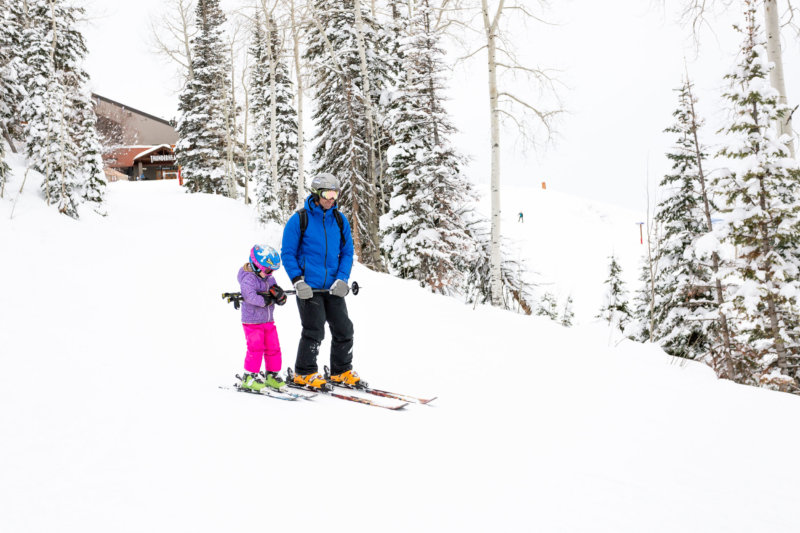
A growing body of research suggests that the changing climate and subsequently warmer winters will drastically shrink the snowpack in mountain states such as Colorado. Already, across the American West, the amount of snow per year over roughly the last 40 years has diminished by 41 percent. For now, Colorado’s altitude and colder temperatures may still protect our winters, in effect, buying some time. But for a state that gets 80 percent of its annual water supply from its snowpack, the future is bleak. Maintaining life as we know it in Colorado is tied to its water supply, and that supply, on both sides of Colorado’s mountains, is inextricably linked to the life and death of snow.
The intangible
When it comes to Colorado’s snowpack, what cannot be measured in inches or feet is as essential as what can be. Snow is an intrinsic part of life in Colorado. The state’s identity is embodied by the majesty of snow-capped Rockies on a brilliant blue day. It is connected to the pure clean hush of snowfall, which drapes mountain pines as elegantly as it does city streets.
It is snow that we rely upon for our water, yes, snow that must fall to fuel tourism and feed crops. But beyond that, deeper than that, snow has the power to transport us, to transform. It can terrify in a whiteout or destroy in an avalanche. It also can return us to childhood, to being breathless, cheeks flushed, stepping, crunch, crunch, crunch, across a canvas of pristine white like astronauts exploring a new planet. Snow is the marriage of the tangible and intangible. A snowball is not just a snowball; it is cold, packed nostalgia. And because this is Colorado with its ever-fickle weather, snow is the guest that comes into town every so often, sometimes on tiptoe, sometimes full of bluster, but rarely overstaying its welcome. In cities and towns, it is white fluff to brown slush to gone in a matter of days.
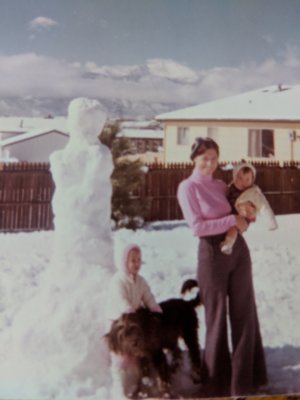
Without snow, “Colorado would become plain, nondescript,” says Michelle Stapleton, a fourth-generation Coloradan who grew up south of Denver but whose family homesteaded deep in the mountains, outside of Snowmass and Grand Junction in the late 19th century. Her grandfather, who still lives on the Western Slope, likes to tell the story of a younger version of himself “walking uphill both ways” because of the constant snowfall. It’s a typical grandpa story in his neck of the woods. But it is also a story now most often told in past tense.
Polly Oberoser and her husband Dave own a ranch outside Gunnison. Polly’s dad, Forrest Cranor, came to the area in the late 1920s looking for work. He found a gig at Crested Butte Ski Resort, one he kept for four decades. Polly, one of four siblings, grew up without much of the money now needed to ski most of Colorado’s resort mountains. She still remembers the exuberance of skiing down the hill behind their Almont home as a kid, the agony of the fall — “snow would get into my mouth, mittens and goggles” — and the dismay once the slope ended and friction drew her skis to an inevitable halt.
Before Polly and Dave bought their ranch, she worked for the ski resort as her dad did, and then put in more than two decades at a local ski shop. Now, when she is out tending to the horses and pigs on her ranch, she has a new appreciation for snow as the force that sustains her land and livestock all year. Snow, she says, is malleable – “the purest form of water.”
“The seasons are important to me, for they ground me somehow,” she says. “Maybe by that I mean they have taught me that our world is constantly changing, a lesson of life we often miss. It seems like when we live and work in changing environments, we are far more rounded.”
It’s snow’s “liquid energy” that inspired David Rothman, the former poet laureate of Colorado’s Western Slope and author of to publish , an ode to snow-capped Rocky Mountain peaks.
Listen to Rothman read ‘Always Somewhere’ below. (Click HERE to read a transcript.)
Rothman is also a former NCAA downhill skier. But these days, for him, skiing is all about the raw, pure backcountry experience. Even after three knee surgeries, he is still enchanted by the poetry of a man climbing up unchartered mountain terrain only to glide to the bottom on skis.
“It is a primal, religious experience,” he says. “The idea is to get to the top of this thing, and it is completely wild. And you put these sticks on your feet, and you get to descend it in this balletic manner, I don’t know what to compare it to.”
As Colorado’s population has grown from 4.3 million people in 2000 to more than 5.6 million today, so, too, has awareness of environmental issues and the threat climate change poses to Coloradans’ love for powder. Colorado College’s that 87 percent of Coloradans believe the state’s year-round recreation opportunities give it an economic advantage over other parts of the country and that voters here increasingly see themselves as conservationists.
But a clock is ticking.
There’s less snow, and it is melting earlier
Scientists agree the shrinking of the snowpack across the American West stems directly from warming winters and climate change. The decline serves as a rapidly flashing red warning sign for what’s inevitably to come to the Colorado Rockies — sooner rather than later if rising temperatures aren’t curbed significantly.
At a meeting of the American Geophysical Union late last year, researchers presented in the U.S. and beyond. The report, published in the journal Geophysical Research Letters, examined trends in snowpack measurements across the continental U.S., finding that changes on the East Coast have been relatively minor so far, but that the West has seen an average 41 percent decline in the amount of snow during winter since the early 1980s. Also during that period, the snow season has become an average 34 days shorter than it was in the 1980s, with spring conditions coming earlier than they used to in the western United States. So not only is there less snow, but it’s also falling later and melting earlier.
The data in Colorado is still somewhat mixed, mostly because of the state’s topography and weather systems. Higher elevations are still seeing close-to-normal snowfall, but lower elevations generally aren’t. The signs of the change to come are beginning to reveal themselves in our own backyards, too. Annual measurements of April snowpack taken since the 1950s showed a 20 to 60 percent decline across most measuring sites in the state, according to .
To make matters worse, Colorado, now in the 19th year of a drought that’s beginning to look more like the new normal, is among the fastest-warming states in the U.S., with temperatures rising an average two degrees Fahrenheit over the last 35 years. Temperatures are expected to continue rising up to 6.5 degrees Fahrenheit by 2050, .
Already, March and November have seen a third less snow across the state compared to 35 years ago. That threatens both the beginning of Colorado’s ski season and the month in which it sees a spike in out-of-state tourism.
Last winter, the driest in 17 years in Colorado, “we had a million less skiers,” says Steven Fassnacht, a hydrologist at Colorado State University who . “So there are some financial implications in these changes.”

Fassnacht and his colleagues on campuses around the state emphasize that Colorado’s higher elevation and consequently colder temperatures, compared to other states across the West, are still protecting winters here from some of the more immediate consequences of our warming climate. Further study is necessary, he and other scientists say, to understand and therefore better predict how — and how quickly — warming temperatures will affect snowfall in the Colorado Rockies.
The problem with measuring snow
The first challenge in measuring climate change’s impact on Colorado’s winters is, in fact, the most basic one: Measuring the snow that is falling. Collecting the reliable, long-term data needed to formulate trends is much harder than it may seem.
“We put a man on the moon almost 50 years ago, but automating snow measurements is still surprisingly difficult,” says Colorado State University climatologist Peter Goble.
There are two main ways to measure snow, says Karl Wetlaufer, a hydrologist with the Colorado Snow Survey,. One focuses on the amount of liquid water in the snow — an automated process using acoustic sensors. The other requires bundling up and going out every month to weigh a sample of the snowpack.
Click on the video below to listen to Wetlaufer discuss snow measurements and its challenges in more detail. (Click HERE for a transcript.)
The challenge, particularly with automated measurements, Goble says, is that wind can impact how deep the snow is at any one point compared to another.
“An automated sensor is going to have no knowledge other than what is right on the snow pillow,” Goble says. “Whereas when you have a human out there in a wind-driven event, they can look around and figure out: Where is a good, representative place to take a measurement?”
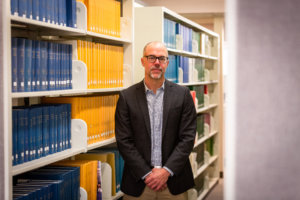
The lack of quality snowpack data from high-elevation sites also impacts the ability to accurately forecast future snowfalls, says David Gochis of the National Center for Atmospheric Research. While technologies like radar-powered airborne measurements are still being tested, the best way to know how much snow has fallen is, as Goble pointed out, getting boots on the ground.
Enter the army of volunteer weather observers, the indispensable support unit to the professional weather services.
How backyard observations drive your weather report
Every day, roughly 10,000 everyday people nationwide report online how much it snowed, rained or hailed in their backyards. They enter their observations into the database. The National Weather Service grabs that data, which is then often used in real time for local weather forecasts or emergency crews responding to big snowfall events in the mountains. Roughly 1,000, or 10 percent, of those observers live in Colorado, where the collaborative has its headquarters in Fort Collins.
Larry White is one of them.
The 72-year-old veteran of the U.S. Forest Service and U.S. Fish and Wildlife has been taking measurements at his home in Evergreen for the past 16 years. A self-avowed weather geek, he takes pride in his meticulous data collection.
“I am not here all the time, but I have nice neighbors who take my place when I’m gone,” he says. Consistency, he — quite sternly — points out, is key in weather data collection. Up here, outside of town, where scattered homes dot the mountain-side, snowfall is a community-building event.
“It gives us something to talk about at the coffee shop,” White says. After all, the white stuff falling from the sky dictates both pace and quality of life in a remote mountain town.
White even loves shoveling snow. Afraid of the mystical forces of the jinx, he to this day has refused to buy a snow blower, despite his long driveway. “If I spend $2,000 on a snowblower, it won’t snow again.”
After he is done measuring the snow, White goes back inside, where a chart with snow crystal shapes based on temperature hangs on the wall. Lately, he has seen mostly the needle-shaped crystals that form in warmer temperatures rather than the wider, rounder shape commonly associated with snowflakes. Warming temperatures not only mean less snow, but a change in snow’s consistency, threatening to turn Colorado’s world-renowned champagne powder into much wetter, slower and more grippy snow.
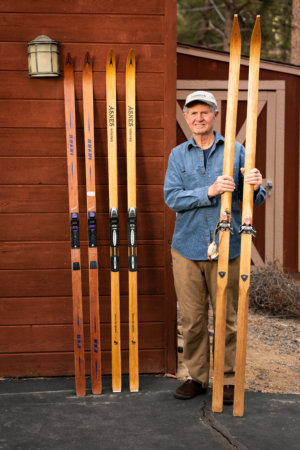
That has a direct impact on White’s biggest passion: Cross-country skiing. The proud owner of a vast collection of nordic skis, White even built his own wooden skis modeled after those of a 19th-century Norwegian farmer. He waxes all his skis himself.
“There is a whole series of waxes for the temperature and the age of the snow,” he explains. When it is cold, as in his favorite skiing spot in Norway, he uses a green or a white wax. If the snow has melted several times and it is warmer, he reaches for a softer wax. “One thing I have noticed in my 30 years of skiing in Colorado,” he says, “is that I am using softer and softer wax.”
White has lived in Colorado for 27 years. He came here from California, via Nevada. It was a move that may have bought him some time before he has to look for a new hobby altogether. Snowfall in his home state is on a pretty much constant decline. But the notoriously variable weather in Colorado has White despairing over a lack of snow one year only to rejoice in its abundance the next.
“But all that snow this year…”
It’s that year-to-year variability that poses the second major challenge for anyone who wants to analyze long-term snowfall trends in Colorado.
Many Coloradans this winter have made their way up the congestion tube better known as I-70 to ski at one of the state’s many resorts. There has been a lot of snow to draw them. In fact, much of Colorado is on track to meet or exceed the state’s snowpack average, says the Colorado Snow Survey’s Wetlaufer. His data shows that the state has also already gotten almost twice as much snow as last year.
A lot of that early season boon came courtesy of, when higher-than-normal temperatures in the eastern Pacific Ocean cause more storms in the American Southwest during snow season.
Wetlaufer calls this early winter’s strong snow accumulation encouraging, “especially for the southern parts of the state that were extremely dry last year.” But, he warns, “I think it is important to remember that it is still very, very early.” To get a snowpack that can break the 19-year cycle of drought in parts of the state, he says, there must be a number of high-intensity spring storms, which are usually wetter in nature due to higher temperatures.
Remember Noah Molotch, the Skittles guy? He’s also a snow hydrology associate professor at the University of Colorado Boulder’s Institute of Arctic and Alpine Research, where he shifts his focus from the perfect line in fresh powder to understanding how it is affected by our changing climate.
Watch the video below to hear Molotch explain snowpack trends in more detail. (Click HERE for a transcript.)
As CSU climatologist Goble, who is also the Colorado coordinator for the Community Collaborative Rain, Hail & Snow Network, further explains: “There is a list of things that we look at as climatologists that make your climate more naturally variable. Is it in the middle latitude? Yes, we are in the middle latitude. These tend to be more variable. Is it intercontinental? Yes, we are intercontinental. That tends to be more variable. Is it higher elevation? Once again, welcome to Colorful Colorado.”
That naturally highly variable climate doesn’t mean that it is not gradually warming, he says. But it drives home the point that precipitation totals here in Colorado have always seen big changes from a wet to a dry year. Reading reliable trends into those totals then becomes, Goble says, “kind of a craps shoot.”
The threat to the ski industry
Perhaps no Colorado industry is watching snowpack data as closely as ski resorts and the multitude of businesses connected to them. In 2014, as many Americans watched the likes of Colorado native Mikaela Shiffrin compete for gold on the downhill alpine course at the Sotchi Winter Olympics, Powder magazine features editor Porter Fox laying out in painstaking detail the existential threat the ski industry is facing.
The highlights, or rather, lowlights, in Fox’s essay: More than a million square miles of snow spring cover has disappeared in the Northern Hemisphere within the last half century. If greenhouse gas emissions aren’t severely curtailed — and soon — snowpack in the Western United States will shrink so significantly that by 2100 it will disappear altogether in lower-elevation ski resorts like Park City and will relegate skiing to places like the top of Ajax Mountain in Aspen. Brown peaks in the middle of winter, Fox warned, may become the norm.
The consequences are not just cultural; they are economic.
A found that Colorado’s ski industry adds nearly $4.8 billion, or 1.3 percent, to the state’s overall $363.8 billion economy. And nationwide, the advocacy organization found that 20 million skiers, snowboarders and snowmobilers are contributing upward of $20 billion to the U.S. economy each year.
Given the billions of dollars at stake, it would seem only natural that the ski industry, nationally and locally, is organizing to fight climate-change inducing policies.
And indeed, in 2013, — and 40 major national companies joined founding signatory Aspen Snowmass to sign on to the Business for Innovative Climate & Energy Policy , which urged federal policymakers to take action on climate change by establishing a framework for sustainable business practices. Aspen Snowmass started the campaign, which aims to politically activate skiers and snowboarders to speak out on warming winters.
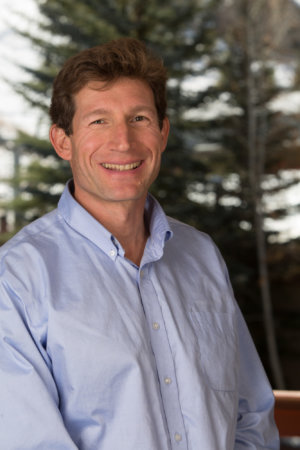
Right now, “there is no future for skiing,” says Auden Schendler, vice president of sustainability at Aspen Snowmass and an outspoken climate action advocate.
Traditionally, being a sustainable business meant reducing your carbon footprint, reporting on the progress of those reductions and buying renewable energy or energy credits, Schendler says. Aspen Snowmass did those things for years while pushing to change the entire grid, he adds. Other places such as Vail have followed suit. But it is not enough, he says.
“There is no such thing as sustainability if you don’t solve the climate problem,” he says. “Are you meaningfully engaged in trying to solve climate change at scale, not in rinky-dink ways? I think that is the hallmark of what you might call a sustainable company.”
What’s needed, he says, is a unified industry push to get Washington to act on climate change — particularly in today’s political climate.
“In a nutshell, the outdoor industry could be as powerful as the NRA in Washington, but on the climate issue,” Schendler says. “But it hasn’t yet used its power.”
“Trade groups tend to be the lowest common denominator,” he says. “In Colorado and nationally, they have membership that doesn’t believe that it is the mission of the trade group to work on climate. They have members who don’t believe the science. So it is very difficult for trade groups to lead, even though they should be leading.”
Schendler’s reading is off the mark, says Geraldine Link, director of public policy at the Lakewood-based National Ski Areas Association.
She points out that when the NSAA adopted its climate change policy in 2002, it made advocacy a key goal. Since then, the organization has come up with its signature . So far, 10 out of 26 Colorado resorts have chosen to take part, all agreeing to do what they can to reduce greenhouse gas emissions and energy use as well as to educate their visitors on how they can do the same. NSAA has also signed on to the national campaign, an initiative that has spawned locally-led efforts to keep the U.S. on track to after President Trump rescinded the United States’ official commitment to the pact in 2017. The association also signed on to the campaign to decarbonize the electric grid.
“We are not waiting on Washington to pass some kind of federal legislation,” Link says. “That will happen, someday. But in the absence of that federal work right now, there is all kinds of initiatives at the local level to decarbonize the grid. A lot of resorts are working with their utilities to increase the amount of renewable energy that is on the grid.”
But those environmental sustainability initiatives also can run headlong into economic imperatives that can further stress the land and tap its resources. For example, Link says NSAA also has been focused on water rights and water access to secure snowmaking operations and lobbied Congress .
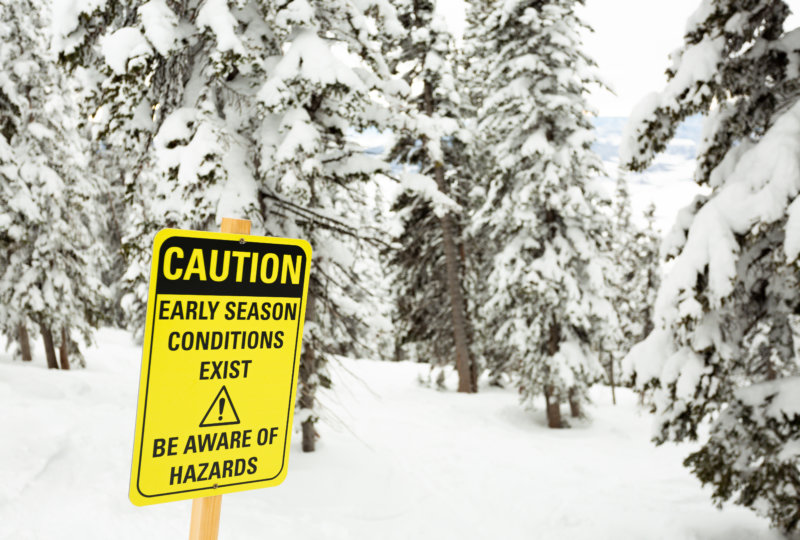
Ski resorts traditionally have made artificial snow to fill up the snowpack. But they still need cold temperatures to produce that snow. And the window to use that technique is becoming smaller, particularly as the early ski season is warming — the time of year most resorts supplement natural powder with man-made snow to build a foundation for the rest of the year.
Faced with evidence of shorter ski seasons, Rose Abello, who oversees Snowmass Tourism, the local government agency promoting the area, takes a matter-of-fact approach to shorter ski seasons: Leave the larger response not up to the government, as Link and Schendler suggest, but to the private sector.
“Businesses will be created, and some will survive and some will go away,” she says. “And we will promote those businesses.”
Chuckling, she says she’s not going to regular meetings where the question is: “‘What are we going to do if climate change makes skiing unavailable?’”
Abello does point out that her office has in recent years spent much time and effort to make Aspen Snowmass a more attractive year-round destination, vying for conferences and special events such as the races that routinely bring more than 10,000 visitors to their tour stops. Occupancy from May to October, she says, has since increased 130 percent — . The problem with attracting summer visitors, Abello acknowledges, is that their vacation habits are different. Winter visitors stay in town for a week to ski, but summer visitors often only make Aspen Snowmass a quick stop on their alpine pilgrimage through the Colorado Rockies.
Looking for answers in politics and science
Aspen Snowmass is not alone in searching for strategies to fight climate change and preserve the industry.
The Steamboat Ski and Resort Corporation is cooperating with scientists like Noah Molotch, who regularly does field work at the Storm Peak Laboratory within the resort bounds. The partnership, Molotch says, is mutually beneficial: Scientists get to study how, for example, clouds affect climate and its changes. (Clouds both cool temperatures by reflecting light and warm them by trapping heat.) Scientists also are studying the impact of particulates from nearby coal plants upon snowfall. And the ski resort gets, among other things, more accurate snow level data to pass on to skiers and snowboarders on its website.
Click on the video to watch Molotch talk about the partnership and the research at Steamboat. (Click HERE for a transcript.)
At the Boulder-based climate advocacy organization , a team of young, idealistic ski and snowboard aficionados is working overtime to unite all outdoor enthusiasts to speak with one voice on climate change.
“We really hit a spot where in 2018 we saw that within the outdoor community it became uncool to not vote,” says Torrey Udall, POW’s director of development and operations. Udall comes from a well-known political family in Colorado. His father was Randy Udall, a nationally-renowned energy sustainability advocate who died while on a hike in 2013. His uncle is former Colorado U.S. Senator Mark Udall, who now sits on the board of the organization’s political advocacy arm, POW Action Fund.
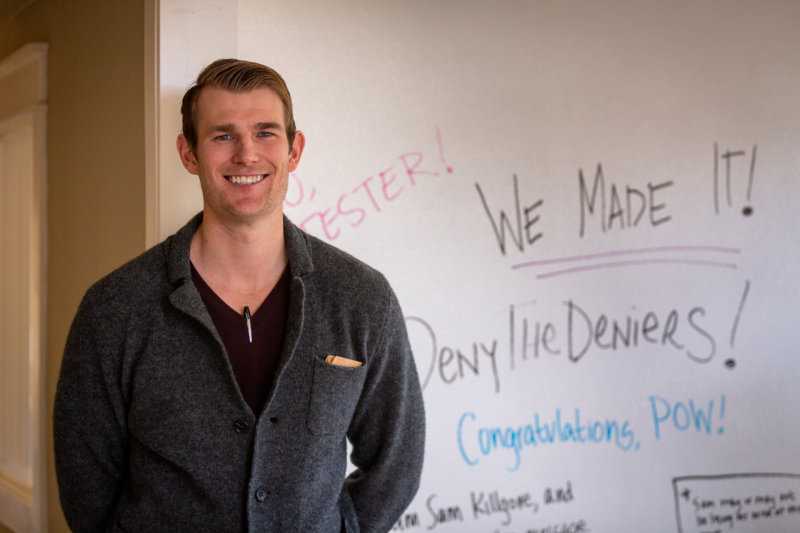
Companies are feeling pressure to sound the alarm, Torrey Udall says. “The industry giants are all speaking out on this issue … And if you are not doing it, people are wondering why, and you are positioned for more blowback than you usually would. That is a shift from five to 10 years ago.”
Udall and Co. are modeling their strategy not just after the NRA but some of the most successful popular reform movements in recent history, including the anti-smoking movement.
“It is key to focus the messaging on what are we for, the solutions that we are advocating, and then how do you build coalitions around that,” Udall says.
After the 2016 election, he says, “the gloves have really come off.” Written in large capital letters on one of the POW office whiteboards: #DENYTHEDENIERS.
Watch the video below of Torrey Udall talking about his family’s legacy and POW’s work. (Click HERE for a transcript.)
In the meantime, scientists and statesare taking winter into their own hands.
How? During every storm, only a fraction of the moisture flowing over the mountains is falling out of the clouds as snow. What if that could be increased? States across the Rocky Mountain West, including Colorado, Wyoming and Idaho, all have established their own cloud-seeding operations. Cloud-seeding even gets a mention in the Colorado Water Plan.
The state currently has 112 ground-based generators blowing particulates into the air in hopes that they crystallize in clouds and fall back down as snow, and it is exploring augmenting that same process via airplanes. California, Arizona and Nevada are pitching in on Colorado’s $1.2 million annual cloud-seeding operation, envisioning that the increase in eventual runoff will bolster the ebbing flows of the Colorado River.
Click below to listen to NCAR meteorologist David Gochis talk about Colorado’s cloud-seeding program. (Click HERE for a transcript.)
Gochis points out, though, that cloud seeding alone is not a sustainable way to save moribund winters — simply because it is costly and only increases snowfall during any given storm by a few percentage points, if that.
And so, as winters are warming, the state’s outdoor and scientific communities are in a race for knowledge, for political power, for time.

At the Storm Peak Lab at Steamboat resort, Noah Molotch closes up a box of instruments and wades through a coat of fresh, fluffy powder back to where his daughter Stella is waiting for him to take her on another Skittle-prompted ski run. His face turns soft as he reflects on the past, present and future of this valley that 27 years ago lured him to the state he now calls home.
“What brought me to Colorado, what kept me in Colorado, are these winter experiences,” he said. “Whether it is Stella’s generation, or her children, or her grandchildren, it is inevitable that on the trajectory we are on, the way people experience winter in Colorado is going to change.”
Next: Spring — a detailed look at a snowpack that is thinner and melting earlier, and the problems that poses for Colorado’s water supply and the lives depending on it.
Source
https://www.coloradoindependent.com/2019/01/23/colorado-snowpack-climate-change/
